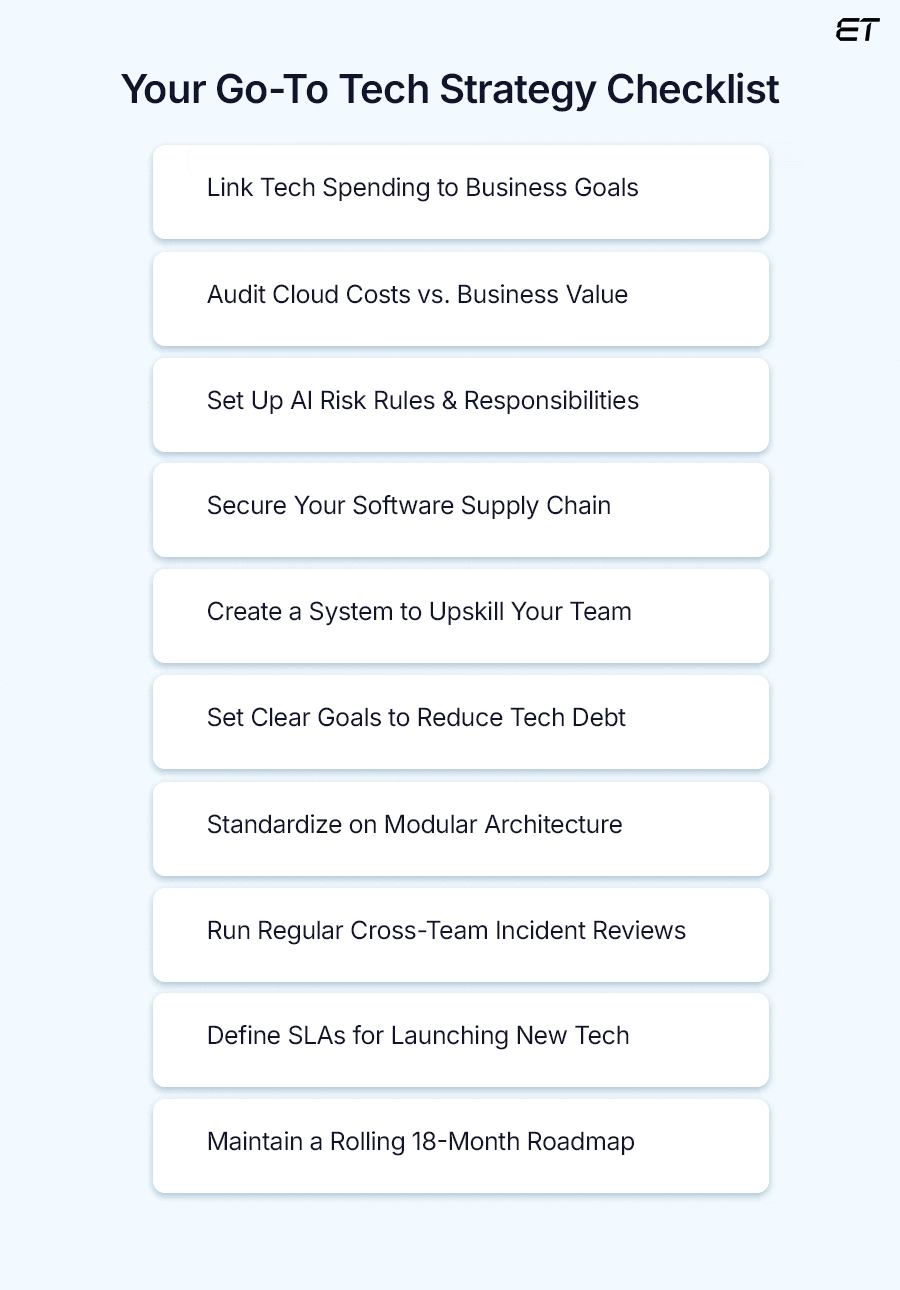
Technology Strategy for CTOs in 2025: Unleash Smart Tech Leadership
Let’s be honest. A technology strategy sounds like one of those corporate catchphrases that everyone nods at, but no one breaks down. But in 2025, you can’t afford to treat it like a vague vision statement.
Today, the expectations from CTOs like you have evolved. You’re not just the tech translator anymore. You’re the decision-maker, risk-mapper, innovation enabler, and (some days) the unofficial crisis hotline for everything. And while AI, cloud, DevOps, and edge computing scream for attention, the real win is this: aligning your tech investments with business outcomes without burning out your team.
Here’s an apt number. 78% of tech leaders admit they struggle to align their tech strategy with business goals. That is precisely where this checklist comes in. Whether you’re refining your 2025 strategy or addressing the issues left behind by 2024, this guide provides a smart, tactical layer.
So, let’s get into the real CTO strategy with a no-fluff playbook.
Stop guessing. Start winning your tech strategy today.
What Is a Technology Strategy and Why CTOs Need One?

The definition:
A technology strategy is a clear plan that outlines how a company will utilize technology to achieve its business objectives. It outlines what tech to adopt, how to manage it, and how it supports growth, efficiency, and staying ahead of the competition.
Think of such a strategy as the GPS that tells your org exactly where to place its next dollar. It connects the dots between technology and hard metrics, such as revenue, resilience, and release velocity. Without this compass, even killer code turns into an expensive museum piece.
Tech Leadership vs. Tech Firefighting
Plenty of heads-down leaders spend Mondays extinguishing production fires and Fridays justifying cloud bills. Strategic CTOs, on the other hand, bake those decisions into a living document that guides hiring, tooling, and vendor bets.
- As you’re aware, AI governance is a hot trend. New global regulations mean your model choices need to be spot on.
- Cloud costs matter to the board.
- Your CTO strategic planning has to factor in flexible work, smarter upskilling, and automation or watch attrition eat velocity alive.
Simply put, the CTO strategy ≠ a once-a-year slide deck
A real technology strategy is version-controlled, peer-reviewed, and measured against OKRs (Objectives and Key Results) on a regular basis, typically every sprint. It should tell you when to sunset legacy monoliths, how to pilot edge cases, and which experiments earn another budget round.
The 2025 CTO Strategy Checklist: 10 Non-Negotiables for Smart Tech Leadership
Below is your no-fluff CTO checklist. It contains ten high-impact moves that anchor a bulletproof technology strategy and sharpen your tech leadership in 2025.

Let’s go more elaborative. Read ahead.
1. Map Tech Investments to Business OKRs
Here’s the deal: Every tool you buy, every project you greenlight, every vendor you onboard — it should all tie back to what the business is trying to achieve.
Ask questions like:
- Is this helping us grow revenue?
- Is it cutting down churn or operational costs?
- Is it reducing risk or boosting delivery speed?
If the answer is missing, you’re likely spending just for the sake of it.
This is where OKRs come in.
Let’s say one of your key results is “reduce customer onboarding time by 30%.” That means the CRM revamp or automation tool you’re investing in should directly push that metric.
And here’s the catch: don’t do this exercise once a year and forget it. Revisit these connections every quarter. Business goals shift. Priorities change. Tech investments should move with them.
Think full-stack development is just code? Think again. See why it’s a game-changer.
2. Run a Cloud Cost–to–Value Audit
Cloud bills often look long, confusing, and full of numbers no one remembers asking for. A cloud cost-to-value audit cuts through that noise:
- Tag every resource by team or product.
- Pull a monthly cost report.
- Match spend to the value each team delivers. Revenue leads generated, and uptime improved.
For instance, if a service is consuming USD 10,000 a quarter and the linked product hasn’t shipped a feature in six months, it’s a red flag.
Publish the numbers internally. Engineers self-police idle resources when they see the actual dollars leaving the building. Do this four times a year, and your technology strategy stays grounded in real ROI instead of wishful thinking.
3. Build and Enforce an AI Risk Governance Matrix
AI is a compliance, legal, and ethical landmine if you’re not paying attention.
That’s where an AI Risk Governance Matrix comes in. It’s a clear system that defines what risks exist, who owns them, and what you’ll do if things go sideways.
Here’s how to break it down:
- List the risks upfront.
- Assign ownership.
- Define the action plan.
- Keep it readable.
- Review it regularly.
New model? New market? New regulation? You update the matrix. No exceptions.
This is responsible tech leadership. Having an AI governance plan signals maturity to investors, customers, and regulators. In short, good AI doesn’t just need GPUs; it needs guardrails.
Want your tech strategy to stay sharp? These GitHub repositories are your best assets.
4. Harden Supply-Chain Security
Here’s the uncomfortable truth: your app is only as secure as the weakest third-party library it relies on. That’s your software supply chain, and if it’s not locked down tight, it’s a front door for attackers.
Having an SBOM (Software Bill of Materials) is a great CTO technology strategy. But you need to think a bit ahead:
- Get visibility into every dependency.
- Use tools that scan continuously.
- Mandate vendor security attestations.
- Automate your patching process.
- Include supply-chain risk in your regular security reviews.
Why it matters? Because attackers now target your entire ecosystem, not just your code. Your technology strategy is incomplete if you’re not treating third-party risk like first-party risk. Secure your stack, secure your business.
5. Build a Repeatable Talent Upskilling System
Tech evolves fast. If your team’s skills don’t keep up, your entire technology strategy falls apart.
The solution?
Stop treating upskilling as a once-a-year L&D checkbox. Develop a repeatable, integrated system that evolves in tandem with your product roadmap.
Here’s what that looks like:
- Run quarterly skill-gap assessments tied to upcoming tech needs.
- Design bite-sized, high-impact learning modules.
- Integrate learning into your sprints.
- Track and reward actual adoption.
Upskilling shouldn’t be delegated entirely to a separate HR silo. It’s a core part of your CTO strategic planning.
6. Set Concrete Tech-Debt Reduction Targets
Tech debt is like cholesterol. You don’t feel it until it clogs everything up. And if you’re not actively managing it, it’s silently slowing down delivery, bloating costs, and frustrating your devs.
So what’s the fix?
Don’t just discuss tech debt in retrospect. Set a measurable reduction target for every release.
Example: Define a 70/30 ratio — 70% new features, 30% tech debt cleanup. Or allocate specific story points each sprint to tackling known debt (refactors, test coverage, infra cleanup, etc.).
Make these targets visible on sprint boards, dashboards, and OKRs.
This habit creates discipline. It signals to your team that quality isn’t optional. And it anchors your technology strategy in long-term velocity. Smart tech leadership knows that if you don’t control debt, it’ll control you.
Don’t let scaling slow you down. Master Azure microservices now.
7. Adopt a Modular Architecture Mandate
Your codebase shouldn’t feel fidgety. That’s where a modular architecture mandate comes in. It’s not just a developer preference; it’s a non-negotiable part of an innovative technology strategy.
Modular architecture refers to building systems from clearly separated, self-contained components. So, when one part needs a revamp or scale-up, you don’t have to rewrite the entire code.
For CTOs like you, this isn’t just about code cleanliness. It’s strategic. It aligns directly with scalability, faster delivery, and risk reduction.
- Set it as a mandate.
- Enforce it via architecture reviews, CI/CD gates, and internal documentation standards.
All in all, tech leadership in 2025 means building systems that evolve without collapsing under their weight.
8. Set Up a Cross-Functional Incident Review Loop
Incidents don’t just belong to DevOps. They impact customer success, product timelines, engineering morale, and even brand perception. That’s why a cross-functional incident review loop should be part of your core CTO strategy.
Here’s how it works: every major incident triggers a short, structured review involving engineering, QA, product, and support. Keep it brutally honest.
Ask:
- What failed and why?
- What signals were missed?
- How can we prevent this across teams, not just code?
The magic happens in shared ownership. Operations might identify infrastructure gaps, but the product may face roadmap pressure due to rushed testing.
Document lessons in a central repository. Feed key takeaways into sprint planning and OKRs. Over time, this loop enhances system resilience, reduces recurring issues, and fosters team alignment.
9. Set SLAs for Shipping Emerging Tech to Production
CTOs love to experiment. AI prototypes, new development tools, and cutting-edge technology. But here’s the trap: too many of these stay stuck in pilot mode. That’s wasted energy, budget, and momentum.
To fix this, set SLAs (Service Level Agreements) for how fast experiments should move to production.
Example: If an AI feature show promise in 30 days, it must have a path to production in 90. Otherwise, it’s archived.
Why this matters: it keeps your technology strategy focused on impact, not just innovation. Teams stay aligned on delivery, not endless Proof of Concepts. And it forces clarity on what’s feasible instead of chasing shiny objects.
Crack the code to remote team success with this CTO playbook.
10. Publish a Rolling 18-Month Roadmap
A smart CTO strategy isn’t about locking plans; it’s about creating clarity with flexibility. That’s where a rolling 18-month roadmap comes in.
Unlike fixed annual plans, a rolling roadmap updates quarterly.
- It always shows the next 6 months in detail (locked in).
- The following 6 with moderate clarity (tentative).
- And the final 6 as high-level direction (vision-aligned bets).
This format keeps stakeholders aligned without overpromising in a volatile tech landscape.
Here’s why it matters:
- Product dept. knows what’s feasible.
- Sales can sell with confidence.
- Engineering avoids random pivots.
- Leadership gains a clear understanding of long-term technology strategy.
So, make the roadmap visible internally and to strategic partners or customers. As a tech leader, your job is to show where it’s going and why. This rolling model of technology strategy provides you with just enough structure to stay focused without stifling innovation.
How to Implement Your CTO Strategy Checklist

Having a splendid technology strategy checklist is one thing. Making it work in the real world is another. Here’s a quick guide to turning theory into impact:
1. Prioritize ruthlessly: You don’t have to do everything at once. Pick 2-3 high-impact items that align with your company’s biggest pain points or goals.
2. Communicate clearly: Share the checklist and your priorities with key stakeholders, including the executive team, engineering leads, and product managers. Ensure that everyone understands the importance of these steps.
3. Assign ownership: Each item needs a clear owner responsible for driving it forward.
4. Set measurable goals: Define what success looks like for each checklist item whether it’s cost savings, faster releases, reduced incidents, or upskilled teams.
5. Review and iterate quarterly: Tech and business goals shift fast. Revisit your checklist regularly, celebrate wins, and recalibrate based on what’s working or not.
Implementation is an ongoing journey. Nail this, and your CTO strategic planning will go from good intentions to measurable business value.
Endnotes
Crafting a winning technology strategy is a continuous playbook that sets the tone for your entire organization. For CTOs in 2025, having a sharp, actionable checklist isn’t optional; it’s survival. From aligning tech investments with business goals to strengthening your supply chain and fostering a culture of continuous upskilling, these steps provide your blueprint for smart, scalable tech leadership.
Remember, the best CTO strategy is practical, flexible, and focused on measurable impact. Use this checklist as your guide, but adapt it to your unique context and team realities.
So, are you ready to move from planning to doing? Start small, prioritize, and iterate. For more such insights, keep following our latest insights!
Your CTO strategy deserves more than ideas. Make it happen with us.
Frequently Asked Questions
1. What exactly is technology strategy, and why does a CTO need one?
A technology strategy is a clear plan that aligns your tech initiatives with your business goals. For CTOs, it’s essential to ensure every tech investment drives measurable value and supports long-term growth.
2. How often should CTOs update their technology strategy?
Updating your strategy quarterly or at least twice a year is critical. This keeps your plans relevant amid shifting market trends, new tech, and evolving business priorities. A rolling roadmap makes this easier.
3. What role does tech leadership play in executing a CTO strategy?
Tech leadership isn’t just about managing teams; it’s about setting the vision, empowering talent through continuous upskilling, and enforcing discipline around priorities like tech debt and security.
4. How can CTO strategic planning help manage emerging technologies like AI?
Effective CTO strategic planning establishes clear Service Level Agreements (SLAs) to transition AI experiments from the lab to production rapidly. This disciplined approach prevents wasting resources and ensures emerging tech delivers tangible business benefits.





